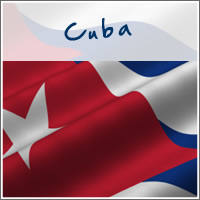|
|
 |
Cuba is located in the northern Caribbean at the confluence of the Caribbean Sea, the Gulf of Mexico and the Atlantic Ocean. Cuba is south of the eastern United States and The Bahamas, west of the Turks and Caicos Islands and Haiti and east of Mexico. Cuba is the most populated country in the whole of the Caribbean. The main island of Cuba is surrounded by four other main groups of islands. The four islands are the Carnaguey, the Canarreos, the Jardines de la Reina and the Colorados. The main island of Cuba consists of rolling plains. It has a range of steep mountains at its southeast end, called the Sierra Maestra. The highest point in Sierra Maestra is the Pico Real del Turquino at around two thousand and five meters (2005 metres). The capital of Cuba is Havana |
The climate in Cuba is tropical. It is moderated by trade winds. There is a dry season from November to April and has a rainy season from May to October. The average temperature is twenty-one degrees Celsius in January and twenty-seven degrees Celsius in July. Cuba is home to hurricanes and destructive storms since it lies on the path of violent weather. These hurricanes are most common in September and October. Like its population, Cuba also has a smattering of religions, making it a very diverse cultural place. The most prevalent faith professed in Cuba is Christianity. Cuba also has Protestants, Jews, Muslims and members of the Bahai faith. Another unique religion that is rampant in Cuba is Santeria, a mixture of Catholicism and other African faiths. Cuba is a major tourist spot. Cuba attracts around two million visitors per year. It has a number of beaches, colonial architecture, favourable climate and a rich cultural history to invite tourists from all over the world Cuba’s agricultural products are sugar, tobacco, citrus, coffee, rice, potatoes, beans and livestock. The flag of Cuba was adopted on May 20, 1902, containing a field with five blue and white stripes, and a red triangle at the hoist with a white 5-pointed star. The flag was designed in 1848 for the liberation movement, which sought to detach Cuba from Spain and make it into a state of the US. "La Estrella", the Lone Star, represented another star that would be added to "the splendid North American constellation." The triangle is derived from the Masonic symbol for equality, while the 5 stripes stand for the 5 provinces of the time. The flag was briefly hoisted in 1850 at Cardenas but was not officially adopted until 1902, when independence was granted by the US. Ironically, the flag's design is based on the US Stars and Stripes. Did you know that Cuba comprises of more than 4,000 islands and cays? |
    |
